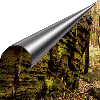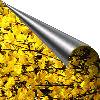

 | Swietokrzyski National Park |  |




 | Swietokrzyski National Park |  |


The Swietokrzyski National Park was established on May 1, l950. It covers the central, best-preserved part of the Swietokrzyskie Mountains (The Holy Cross Mountains). The mountains take their name from an old Benedictine Abbey, that is located on the Lysa Mountain. These mountains are, beside the Sudety Mountains, the oldest Polish mountain formations, and are built from Paleozoic rocks. The rich geological history of this area involved successive inundations by sea, transformations of sediments into rocks, and their folding. The main mountain-building movements, the Variscian movements, occurred here some 300 million years ago. In the Quaternary period the Swietokrzyskie Mountains were temporarily covered by glaciers, which formed the boulder fields known in the Polish language as goloborza, on the slopes of the highest peaks in the range.
The symbol of the Park is the stag (Cervus elaphus).
The present Park area is 5,917 ha, but there are plans to enlarge it to about 7,600 ha. The Park entails the the three mountain ranges, the Lysogory with the highest summits of Lysica (612 m above sea level) and Lysa Gora (Bald Mountain, 595 m above sea level), the eastern part of the Klonowskie Range with the hills Psarska (412 m above sea level) and Miejska (428 m above sea level), and the Pokrzywianskie Range with Chelmowa Gora (351 m above sea level). These are separated by three valleys, Wilkowska, Debnianska, and Slupianska, parts of which are also included in the Park.
Natural values
The first attempts to protect the area's environment date back to the year 1909. As a result, the Chelmowa Gora reserve was established in l920 and the Lysa Gora (Swiety Krzyz) and Lysica became reserves in 1922. Today, the Park has five strict reserves covering about 30 % of the total area:
The remaining territory is protected as partial reserves.
- Chelmowa Gora (13 ha): larch (Larix polonica)
- Czarny Las created in 1947 (26 ha): fir-tree (Abies alba), durmast (Quercus robur L.), pine (Pinus sylvestris L.), linden (Tilia)
- Lysica created in 1924 (1164 ha): goloborza, fir-trees (Abies alba) and beech trees (Fagus sylvatica L.)
- Mokry Bor created in 1954 (38 ha) sources of the Czarna Woda Stream, pine (Pinus sylvestris L.), spruce (Picea abies)
- Swiety Krzyz created in 1924 (451 ha): goloborza, fir-trees (Abies alba), beech trees (Fagus sylvatica L.), sycamore (Acer pseudoplatanus L.), spruce (Picea abies)
The Park belongs in the submountain climatic zone. Mean annual temperatures range from 5.8oC at Swiety Krzyz to 7.8oC at Nowa Slupia. Mean annual rainfall range from 673 mm on Chelmowa Gora to 933 mm at Swiety Krzyz. Rocks in the Park area are composed mainly of quartzite, sandstone, graywacke, and slate. More than 94 % of the Park area is covered by forests, mainly fir, beech, pine, oak, larch, black alder, birch, and other tree species may be found. Fir and beech forests are a typical element of the landscape, especially on the ridge and slopes of the Lysogory. Open areas such as forest clearings, boulder fields, and marshes, add variety to the Park's landscape, even though they cover only a very small area of some 3 %.
The flora and fauna of the Park include some protected species, for example, fir-club moss, tropical fern, gentian Acontinum variegatum, Siberian iris, as well as beaver, black stork, smooth snake, and other animals.
The goloborza, vast fields of rock scree, are especially imposing on the northern slopes of Lysa Gora and Lysica, and are a local peculiarity. The Cambrian quartzite in the Lysa Gora region contains the traces of organic life hundreds of millions years old, including the Cambrian Corallicyathida, and fossilized algae.
Human impact
Human activities in this area started before the Iron Age. The clear evidence of copper ore mining, red sandstone cutting, and iron smelting, have all been discovered at Rudki near Chelmowa Gora hill, and at Nowa Slupia, a village that now hosts the museum of ancient iron smelting.
Lysa Gora (also called Lysiec or Swiety Krzyz) was a site of a pagan cult in Roman and early medieval times. After the Baptism of Poland, a church and a monastery were built here by the monks of the Benedictine order from Hungary, in all probability settled here by King Boleslaw the Wry-mouthed in the l2th century.
While mining and iron smelting ceased, the agriculture developed in this area. The land was cleared of forest, which remained only on the mountain slopes, ridges, and in marshy regions, where it retained its natural shape. Today the Park is an island of forest amid the farmland. The agriculture of this region is characterized by small farms and traditional farming methods.
The Swietokrzyski National Park is one of the few national parks in Poland, which besides its beautiful nature and landscapes, boasts many architectural monuments. Among the most valuable is the complex of the former Benedictine abbey on Lysa Gora, called Swiety Krzyz (Holy Cross). It includes the Baroque-Neo-classical church built in 1781-1789, the Gothic cloister from the l5th century with a fragment from the 12th century, the Romanesque wall, and the Olesnicki Chapel (early l7th century), which contains the Holy Cross relic. Today, the west wing of the monastery houses the Research Laboratory and the Park's Museum. The oldest preserved piece of Polish religious prose from the 13th/l4th century, known as The Swietokrzyskie Sermons, is associated with the monastery. The remnants of the 14th century bishops' castle at Bodzentyn are an interesting example of lay architecture. The rural style of building in the Swietokrzyski region is represented by an old, l9th century farmhouse, preserved in the same village.
For years, the nature of the Swietokrzyskie Mountains has been a source of inspiration to many artists, writers, and poets, including folk artists. The works by Stefan Zeromski and Jan Gajzler contain the most beautiful descriptions of the local nature.
The Park
The Park serves a protective, scientific, educational, and recreational role. Protection is either passive (in strict reserves, where any direct interference by man is forbidden), or active (in partial reserves, through man's conscious effort to protect and restore nature). Scientific research is carried out on Park territory. The Park's Museum at Swiety Krzyz, and the historical and nature trails, serve a didactic purpose. Tourists have 26 km of marked trails inviting for exploration.
Nevertheless, the Park environment is threatened mostly by pollution, and the excessive penetration by a local population. The Swietokrzyski National Park is one of the most endangered national parks in Poland. It has already witnessed the disappearance of ca. 25 % of the lichen species, and many species of symbiotic fungi. In recent years fir trees have begun to die out, while many other living organisms have become weaker.
Fortunately, the Park has always had many devotees to its foundation and maintenance, thus hopefully will survive the human assaults. Among those who used their energy and enthusiasm to promote the cause of the Park, one should count on people such as the writer Stefan Zeromski; two great scientists Professors Wladyslaw Szafer and Wlodzimierz Sedlak; the geographer Edmund Massalski - one of the investigators of the Swietokrzyski National Park; Eugeniusz Krysztofik - the first director of the Park; and photographer Jan Siudowski - the author of beautiful pictures of the Park.



If you know any WWW sites that reference Polish National Parks please e-mail them to me.
Your input will be greatly appreciated.